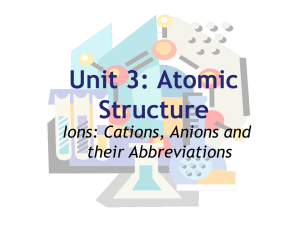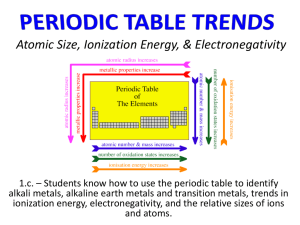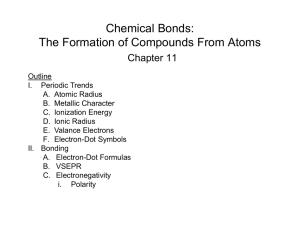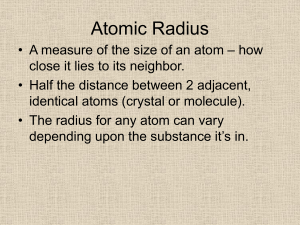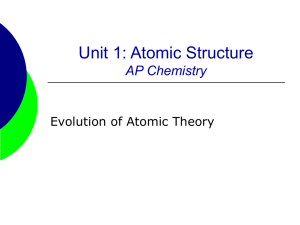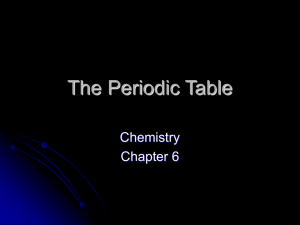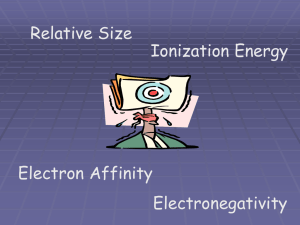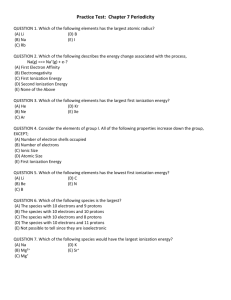Ch. 6.3 – Periodic Trends
advertisement
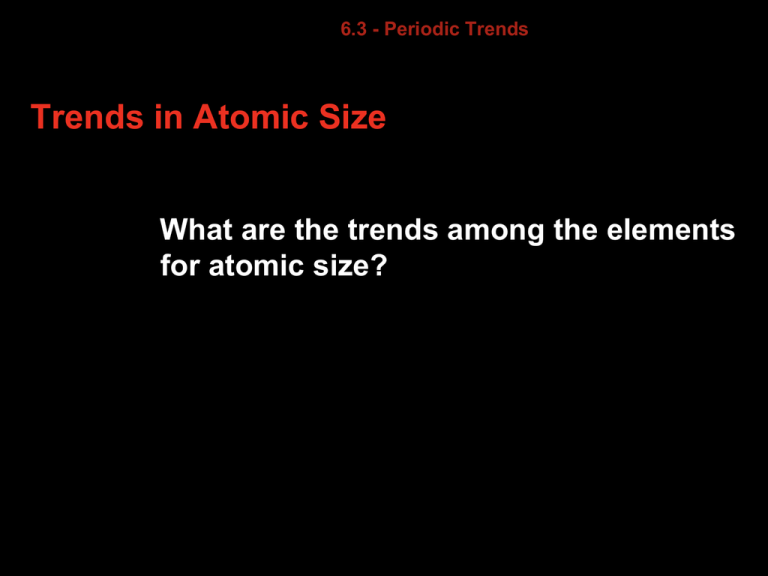
6.3 6.3 - Periodic Trends Trends in Atomic Size What are the trends among the elements for atomic size? 6.3 Trends in Atomic Size The atomic radius is one half of the distance between the nuclei of two atoms of the same element when the atoms are joined. 6.3 Trends in Atomic Size Group and Periodic Trends in Atomic Size In general, atomic size increases from top to bottom within a group and decreases from left to right across a period. 6.3 Trends in Atomic Size 6.3 Trends in Atomic Size 6.3 Ions Ions How do ions form? Ions Positive and negative ions form when electrons are transferred between atoms. Na becomes a positive ion, Na+ Ions Positive and negative ions form when electrons are transferred between atoms. Chlorine becomes a negative Chloride ion, Clˉ 6.3 Ions • An ion is an atom or group of atoms that has a positive or negative charge due to an uneven number of protons and electrons. • A cation is an ion with a positive charge (+). • An anion is an ion with a negative charge (ˉ). Anions are Negative 6.3 Trends in Ionization Energy Trends in Ionization Energy What are the trends among the elements for first ionization energy, ionic size, and electronegativity? 6.3 The energy required to remove an electron from an atom is called ionization energy. • The energy required to remove the first electron from an atom is called the first ionization energy. • The energy required to remove an electron from an ion with a 1+ charge is called the second ionization energy. 6.3 First ionization energy tends to decrease from top to bottom within a group and increase from left to right across a period. 6.3 Trends in Ionization Energy 6.3 Trends in Ionization Energy Trends in Ionization Energy 6.3 During reactions between metals and nonmetals, metal atoms tend to lose electrons, and nonmetal atoms tend to gain electrons. The transfer has a predictable effect on the size of the ions that form. 6.3 Trends in Ionic Size Cations are always smaller than the atoms from which they form. Anions are always larger than the atoms from which they form. 6.3 Trends in Ionic Size Relative Sizes of Some Atoms and Ions Trends in Ionic Size 6.3 Trends in Electronegativity Trends in Electronegativity Electronegativity is the ability of an atom of an element to attract electrons when the atom is in a compound. In general, electronegativity values decrease from top to bottom within a group. For representative elements, the values tend to increase from left to right across a period. The term electronegativity is defined as the attractive force on electrons caused by the nucleus. Electrons are negatively charged, and the nucleus is positively charged; therefore, opposites attract. Electronegativity is the atomic tug o’ war – whichever element has a higher electron affinity and ionization energy will also have a higher electronegativity 6.3 Trends in Electronegativity Representative Elements in Groups 1A through 7A 6.3 Summary of Trends Summary of Trends What is the underlying cause of periodic trends? 6.3 The trends that exist among these properties can be explained by variations in atomic structure, such as effective nuclear charge and electron shielding. 6.3 Section Quiz 1. Which of the following sequences is correct for atomic size? a. Mg > Al > S b. Li > Na > K c. F > N > B d. F > Cl > Br 6.3 Section Quiz 2. Metals tend to a. gain electrons to form cations. b. gain electrons to form anions. c. lose electrons to form anions. d. lose electrons to form cations. 6.3 Section Quiz 3. Which of the following is the most electronegative? a. Cl b. Se c. Na d. I END OF SHOW

